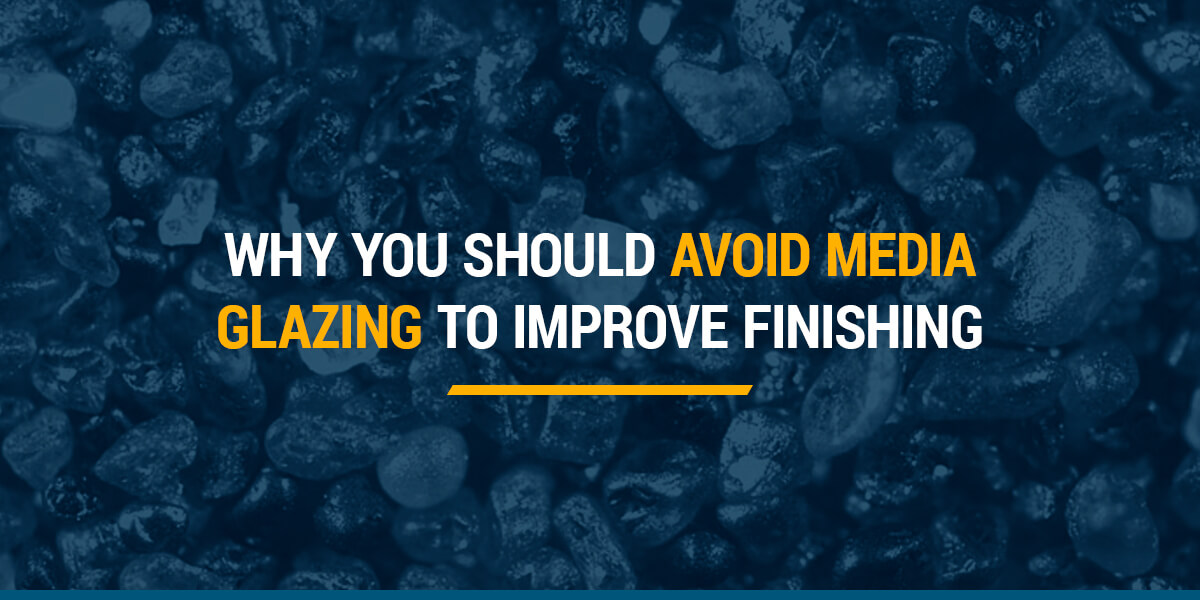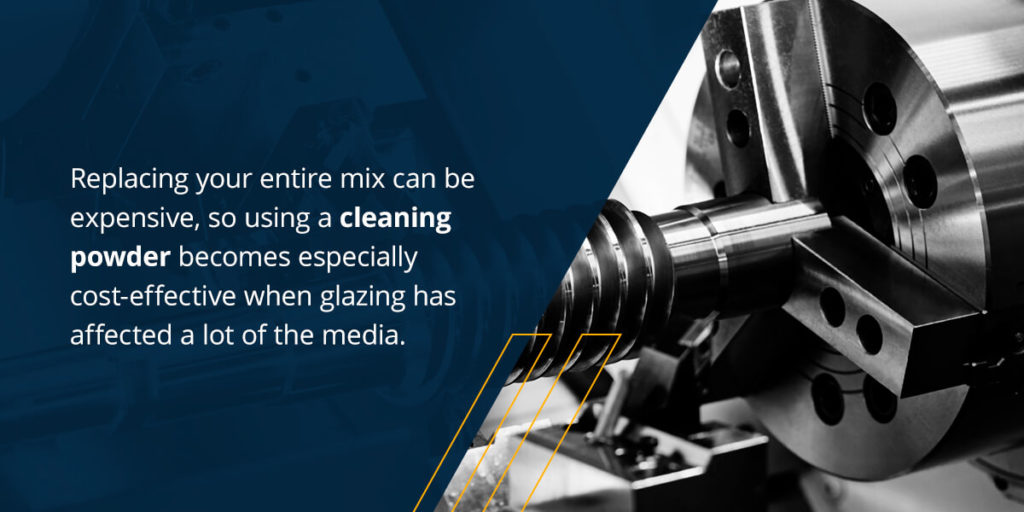
Why You Should Avoid Media Glazing to Improve Finishing
Updated: March 12, 2024Abrasive media is an essential part of surface finishing across multiple industries. Finishing process options include ceramic, plastic and steel that effectively deburr, smooth, clean, burnish, polish and brighten workpieces. Over time, however, glazing can cause your media’s effectiveness to decrease, leaving you with imprecise and inconsistent finishing results. Learning more about this phenomenon, its causes and how to prevent glazing is key to achieving the high-quality results you want and your customers expect.
What Is Media Glazing?
When you use media to finish a product, the vibratory function causes friction, making the workpiece rub against the media to remove burrs loosen dirt and smooth the surface. Finishing professionals will typically use vibratory finishing machine for this process. Media glazing occurs when fine metal particles and other debris from the workpieces begin to coat or load the media itself.
Because media works with abrasion, glazing removes its surface properties and makes it ineffective. Instead of creating a clean and consistent finish, the glazed media will stop cutting and leave an inconsistent finish or burnishing effect on the workpiece. What’s more, it can pass the dirt and metal particles from its surface to that of the workpiece.
The advantages of avoiding media glazing are undeniable, such as lower cycle times. Glazing often leads to an increased cycle time, creating workflow bottlenecks and limiting productivity. Preventing it supports process efficiencies to maintain consistent throughput. Similarly, unglazed media helps preserve better finish qualities without rework by fully removing burrs or burnishing the surface.
Enjoying these benefits starts with a better understanding of the many variables contributing to media glazing.
What Causes Glazing?
Although numerous factors lead to glazing, the most common ones involve:
- Compounds: Using a compound concentration that’s too low can prevent the media from getting fully cleaned during the finishing process which could lead to glazing.
- Water flow: An adequate water flow flushes metal particles and other debris from the tumbling machine. A low water flow prevents contaminants from leaving the system, allowing them to glaze the media.
- Ratios: A high part-to-media ratio can cause media glazing, especially when finishing workpieces with excess grease and oils.
- Media size: Media that’s too small can clog your machine’s drain and prevent the process water from leaving the system. The dirty water then coats the media.
What Causes Glazing?
Although numerous factors lead to glazing, the most common ones involve:
- Compounds: Using a compound concentration that’s too low can prevent the media from getting fully cleaned during the finishing process which could lead to glazing.
- Water flow: An adequate water flow flushes metal particles and other debris from the tumbling machine. A low water flow prevents contaminants from leaving the system, allowing them to glaze the media.
- Ratios: A high part-to-media ratio can cause media glazing, especially when finishing workpieces with excess grease and oils.
- Media size: Media that’s too small can clog your machine’s drain and prevent the process water from leaving the system. The dirty water then coats the media.
6 Tips on How to Prevent Glazing
You can prevent glazing by carefully preparing your tumbling machine before each use.
1. Use the Proper Compound With the Correct Media and Material
Glazing tends to happen faster with softer workpiece materials, including:
- Copper
- Brass
- Certain non-heat-treated steel
- Aluminum
Choose the best compound for your equipment and workpiece to ensure you’re using the right mix for the job. An incorrect compound for the water condition and materials can create undesirable results.
2. Inject the Right Concentration of Compound Into Your System Before Use
Using an accurate concentration of the compound is equally as vital as using the right media for the material and machinery. This amount often ranges between 0.7% and 1% according to the water volume and equipment capacity. A concentration too-low generally leads too glazing increasing the run time to acheive the finishing result.
3. Ensure the Drains Are Clear to Prevent Clogging and Process Water Retention
It’s a best practice to ensure drains are open and free of clogs before processing. If your workflows or wastewater restrictions require a closed drain, consider frequent freshwater replacements to prevent soils from concentrating and glazing the media.
4. Maintain an Adequate Water Flow to Flush Out Sediment and Ensure Correct Cycling
Open drains with adequate water flow typically produce the best results since the liquid can whisk away media residues for cleaner finishes and finishing environments.
5. Analyze Your Wastewater Stream
Concentrated or dark wastewater often occurs with processes involving:
- Materials with low-quality metallurgical traits
- High part-media ratios
- Larger manufacturing oil or grease residues and concentrations
If your workflows include any of these, it’s important to monitor your media regularly for productivity and consider process audits to improve or maintain results.
6. Check the Size of Your Media and Refresh It as It Degrades
Implementing scheduled media checks can help you protect your productivity and get the finishing outcomes you want. Change out any media with particles too small for the intended process, workpiece material and equipment. You should also promptly replace or restore any media that shows visible signs of degradation or glazing.
Tips for Restoring Media
While media glazing decreases the quality of a finish, it is possible to restore the media and its previous effectiveness. You can start by adding an abrasive cleaning powder to the media and running the tumbling machine for a few hours. Once the cycle finishes, flush the media with water to remove excess sediment and dirt. Replacing your entire mix can be expensive, so using a cleaning powder becomes especially cost-effective when glazing has affected much of the media.

Get in Touch With Finishing Systems Today
While media glazing causes inconsistent finishes, there are ways to prevent it and restore damaged media. At Finishing Systems, our team is on hand to provide solutions to all your finishing needs. Contact us online today to learn more about media glazing or ask a question about our products and services.
